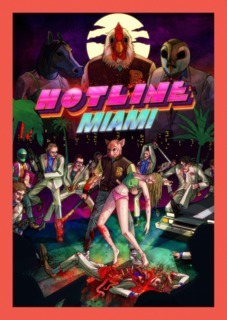Hotline Miami is uniquely schizophrenic, both arcade-like video game pulp and mesmerizing storytelling.
As a game, Hotline Miami is very straightforward with its intentions. It plays like a twin-stick shooter with some melee weapons thrown in. There's really only one rule in each level: kill everything that moves. At the end of each section, the player is scored based on variety, quantity, speed, and the all important style. This scoring along with the leaderboards could have been what put Hotline Miami over the edge as a top shooter, but the primal competitive drive is dampened by controls that are merely adequate. The right stick is used for aiming, but it must be fully tilted before any aiming can be performed. This creates a delay that is unsuitable for high level play.
That isn't to say that Hotline Miami is broken, merely built for completion rather than perfection. Players can work around reflex shooting with a variety of options besides a limited lock-on feature. Melee weapons are silent options for close corridors, making them sometimes even more effective than guns. They can also be thrown for a one shot ranged attack. Doors are valuable weapons of their own, both concealing your movements and knocking over nearby goons to make them vulnerable to finishers. Add in glass walls and numerous other level design quirks and encounters become live-for-the-moment affairs fueled by a hyper attention to detail, similar to cocaine highs. And why shouldn't they be about one moment to the next? One bullet will kill the player, meaning death is always just around the corner.
However, Hotline Miami functions best as a piece of storytelling where it is most troubling. The city of Miami is depicted with false lights of neon, but overt nods like setting a killing spree in an arcade call attention to the fact that you are playing a video game. There is hardly any HUD outside of the action, but such trappings would be unnecessary. Hotline Miami lures the player in with hypnotic pacing and then combo counters and high scores become as real as anything. The world comes alive in its falseness.
The nameless protagonist also revels in how fake everything feels. He acknowledges the desire to be someone else. At the beginning of each mission, he dons a mask complete with a whole new persona. Among others, Aubrey the pig hoards guns, George the giraffe has a better view, and Rami the camel rations ammo. He commits violence through an avatar just as the player does.
These two identities, arcade shoot-em-up and mirror into players, are hopelessly inseparable. The medium as a whole has also wrestled with power fantasies and violence. People fantasize about being the superhero rather than the secret identity, no matter what acts the hero commits. We perhaps even prefer the antihero. Hotline Miami firmly states that this isn't due to positive reinforcement.

